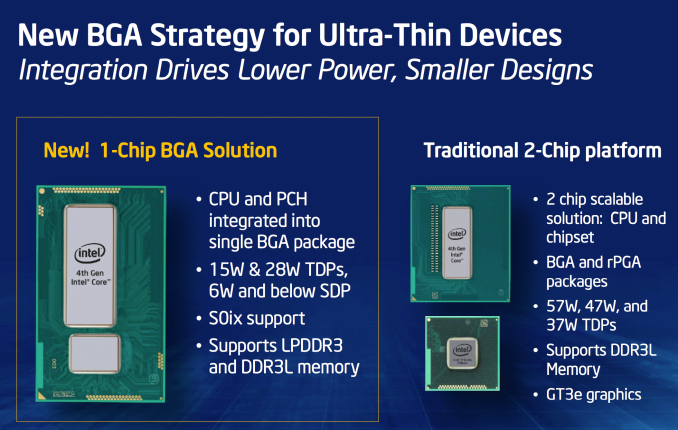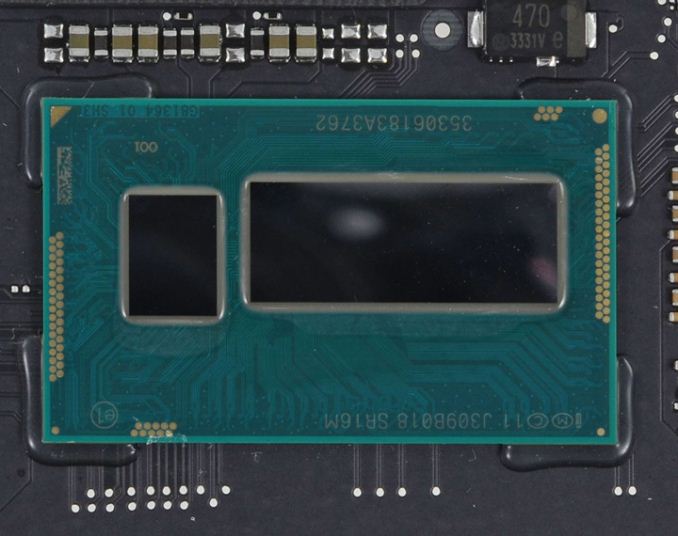The 2013 MacBook Air Review (13-inch)
by Anand Lal Shimpi on June 24, 2013 12:01 AM ESTThe CPUs
Apple keeps things simple across the 2013 MacBook Air lineup by configuring both 11 and 13-inch models with the same base CPU: a Core i5-4250U.
To understand Apple’s CPU choice, you have to understand that Apple is primarily concerned about improving battery life this generation. The line between MacBook Air and MacBook Pro has to be well defined. The Air is about portability, while the Pro is about performance. When faced with a power/performance tradeoff, it’s clear on which side of the fence Apple will fall whenever the MacBook Air is concerned.
| Apple 2013 MacBook Air CPU Comparison | |||||
| 1.3GHz dual-core | 1.7GHz dual-core | ||||
| Standard On | 11 & 13-inch MBA | Optional on Both | |||
| Intel Model | Core i5-4250U | Core i7-4650U | |||
| Base Clock Speed | 1.3GHz | 1.7GHz | |||
| Max SC Turbo | 2.6GHz | 3.3GHz | |||
| Max DC Turbo | 2.3GHz | 2.9GHz | |||
| L3 Cache | 3MB | 4MB | |||
| TSX-NI | No | Yes | |||
| TXT | No | Yes | |||
| AES-NI | Yes | Yes | |||
| VT-x/VT-x EPT | Yes | Yes | |||
| VT-d | Yes | Yes | |||
| TDP | 15W | 15W | |||
| Processor Graphics | Intel HD 5000 | Intel HD 5000 | |||
| GPU Clock (Base/Max) | 200/1000MHz | 200/1100MHz | |||
The lower base clock alone shouldn’t mean much, but the max TDP of the CPUs in the new MacBook Air falls as well - from 17W down to 15W. The thermal limit is even more dramatic since with Haswell ULT, the 15W includes the CPU/GPU as well as the on-package PCH. In Ivy Bridge the PCH was off package and wasn’t included in the 17W TDP.
Max turbo clocks are identical between the Haswell ULT CPUs Apple picked this round and the Ivy Bridge models before, but with a lower TDP it’ll be harder to always sustain the same frequencies given the right workload.
Haswell does feature a not insignificant gain in IPC compared to Ivy Bridge, which should help offset the power constraints that could otherwise force a larger regression in performance.
Both 2013 MBAs ship with the same CPU by default, and both can be upgraded to the same higher end SKU: a Core i7-4650U. The 4650U retains the same 15W TDP as the i5-4250U, but it increases its base clock speed to 1.7GHz and max turbo to 3.3GHz. The L3 cache also grows from 3MB to 4MB. All in all, this should be a very healthy upgrade in performance. Intel likely maintains the same TDP by binning for power; the i7-4650U is probably capable of running at higher frequencies without any appreciable increase in voltage. The max GPU clock also goes up by 10%.
Haswell ULT, Courtesy iFixit
What's arguably coolest about the i7-4650U is it enables Haswell's Transactional Synchronization Extensions (TSX-NI), a feature which is unfortunately disabled on the i5-4250U. I don't suspect this will matter much for most MBA users, but anyone looking to play around with Haswell's TSX instructions will want to opt for the higher end SKU. The upgrade costs $150 regardless of base model. Intel charges $454 for the i7-4650U and $342 for the i5-4250U, a difference of $112; Apple is adding another $38 onto the 1KU pricing, which isn't unreasonable.
Many have asked me what the impact of the i7 will be on battery life. I'm hoping to get my hands on an i7 based machine when I return from the UK in a week, but for those of you making immediate decisions I'll offer the following. Sustained operation at higher frequencies will likely draw more power, and negatively impact battery life. Light to medium workloads will enjoy a mix of race to sleep benefits as well as higher power consumption under load. Idle power should be roughly similar between the parts however. For most workloads I'd expect a modest impact to battery life, but it won't be enough to regress to 2012 levels of battery life. All of this is said without knowing key details like operating voltage for most 4650Us. I plan on addressing that shortly.












233 Comments
View All Comments
appliance5000 - Friday, December 20, 2013 - link
One word - tablets.mikeztm - Monday, June 24, 2013 - link
Could that PCIe ssd works with Filevault2 without performance down?My 2011 MBA's SSD became much slower after enabling Filevault2.
|-8-| - Monday, June 24, 2013 - link
>Five years after its introduction, the MacBook Air really has>grown into a very polished, mature platform. The 2013
>model is really the epitome of what Apple set out to
>build back in 2008, we just finally have the right hardware
>available to realize the vision. Nearly every component has
>been perfectly selected.
For a ultramobile working horse, there are still some substantial shortcomings: It's still a glossy display tying your work place to indoor use or cloudy weather. There is still no LAN, no VGA - this makes many headaches in business everyday life.
Maybe the author better leaves the marketing to Apple and concentrates on listing the Pros AND Cons of the product. It's a fine notebook, but definitely not perfect. ;)
weiran - Monday, June 24, 2013 - link
You forget not everyone works in a corporation and has your requirements, especially considering this is a consumer device first and foremost. Apple looks to the future, which may mean minor pain in the short-term (having to use adapters for LAN and VGA), but realistically do you think in 2-3 years either of those will exist on any consumer laptop?|-8-| - Monday, June 24, 2013 - link
It's not about having these or that requirements. The author is praising something to the skies, that has obvious short comings. (Every product has that.) What would be more 'neutral' verbalised: The components are perfectly selected. [...]. There are a few compromises, so the screen has good contrast, but isn't really usable outside, for example in a park. Further missing legacy ports force to carry adapters for using old legacy infrastructure like LAN networks or common LCD projectors.It's about writing a review - I don't want to read someones marketing arguments.
And by the way: Yes, VGA and LAN will be important in the future - most LCD projectors still have VGA and in contrast to HDMI or Displayport it really works reliable. I was at a conference a month ago - VGA saved me as Displayport wasn't working at all.
LAN is without alternative to share and synchronise big amounts of data.
Grennum - Monday, June 24, 2013 - link
VGA is certainly dying. By the end of the year all of the projects in our boardrooms will be replaced with Smart Screens, which you connect to via Wi-Fi. We have wired HDMI as a back-up works perfectly.Wired LAN is not dying by why would you ever have large amounts of data on your ultra portable laptop? That is just be irresponsible. If you are working with large data sets best to do it on a remote system where you have the performance, and reliability.
This laptop would perfectly meet the needs for many of our business users, maybe not engineering, but then engineering wouldn't be looking at an ultraportable (remote engineering desktops notwithstanding)
|-8-| - Monday, June 24, 2013 - link
Maybe I should switch to your company. ;) There are some new projectors here having HDMI (sadly no Displayport). But most projectors are quite old (still working), these are connected via VGA. There is some time left, till the last old projectors die.Honestly I don't see a bonus in digital alternatives. THE standard is still missing, as most notebooks have either HDMI or Displayport.
WLAN seems to have high signal latency between two computers. If you syncronise two big collections of many many subfolders and many small files in there, you notice a huge difference even between 100 MBit/s LAN and 300 MBit/s WLAN. I use WLAN for backups, but speed sucks.
Another problem is security of data in the private sector, these security guys don't like WLAN.
A5 - Monday, June 24, 2013 - link
Then maybe don't work in a park? I don't know of any laptop with a bright enough screen and good enough battery life to actually work outdoors.|-8-| - Monday, June 24, 2013 - link
Well, the Samsung Series 9 900X3C-A04DE or the Lenovo x220/x230 are two, that can be used outdoors. There should be more, some Zenbooks have also matte screens.darwinosx - Monday, June 24, 2013 - link
Well Samsung makes cheap junk that doesn't work and has no support.